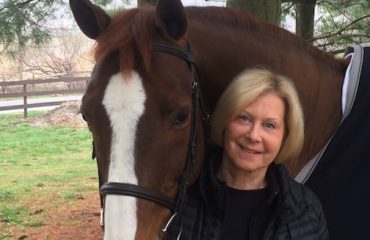
Margie Sugarman
Photo by Lauri Foster
By Margie Sugarman
Margie Sugarman is a leading board-certified psychotherapist and sports consultant based in New York. Margie’s desire is to enhance performance through the connection between the mind and body, and her current client list includes Olympic, professional and amateur athletes across the country. Her experience employing various therapeutic modalities has helped equestrians win classics, junior medals and grand prix. Do you have a question you want Margie to answer? Send questions to editor@sidelinesnews.com.
I am a competitive rider and I don’t use any psychological techniques to improve my riding. However, I have noticed other riders do and I often hear them talking. I wanted to know if this is a fad that will fade, or should I consider investing my time and learning some of these strategies? What sort things do you recommend and why?
As a competitive rider, I’m sure you spend a tremendous amount of time, money and effort on your training. Additionally, there are the expenses for your horse and equipment. What’s interesting is that one can spend all the money they want on lessons and physical training but without training the mind, it’s like running a race with a broken leg. Ninety percent of performance is mental. Without the mind/body connection, it’s almost impossible to perform to the peak of one’s ability.
In any type of competitive situation, adrenaline starts to pump within your body. When this occurs, we often have various physiological responses: Your palms might get sweaty; your heart might beat faster than normal; your breathing might change (you might find it’s tougher to get all the air you need); and your thoughts might not stay focused on the present (your mind may stray to past/future events).
Your body is responding to the situation with a stress response. All the physical training you’ve done to improve your riding isn’t going to address and correct this mind/body response. In times of stress, our behavior is being impacted by our thoughts and internal dialogue. Performance anxiety doesn’t allow someone to make good decisions, solve issues or stay composed.
One needs to create a calm and alert state of mind to perform well. Of course, some degree of stress is normal, and may be helpful, in athletics. However, there is a way to moderate that stress by calming the mind. Studies have shown that mindful meditation (different modalities for different people) lower the cortisol levels (stress hormone) in the brain. If we utilize the proper methods, we can bring our attention inward, activate the insular cortex of the brain and experience heightened awareness and communication between our mind and body. Through these methods, one learns how to reduce the mental noise, tune out distractions and retain a higher ability to stay in the moment — all resulting in enhanced performance.
There are many in-depth techniques that can be utilized to enhance performance. A few simpler techniques that will benefit any athlete are:
- Breathing: Brain states are related to relaxation. The lower the brain state, the more relaxed the body is. Breathing from the chest (anxiety state) doesn’t allow there to be a good mind/body connection. Diaphragmatic breathing must be utilized to lower the brain state, allow the mind and body to communicate and ultimately keep the mind in the present.
- Internal Messages: Our internal dialogue plays a large part in our external behaviors. What you think ultimately impacts what happens in reality. If you constantly tell yourself you always mess up oxers, you will shape your mental state and imprint that thought so you, in fact, always mess up oxers. Working on techniques to change negative “self-talk” statements to positive statements results in profound behavioral changes. Restructuring your thoughts can have you jumping oxers as well as any other fence.
- Visualization and Imagery: Imagine only watching a video of yourself making mistakes when riding. You watch this tape over and over. What happens? Seeing yourself ride the mistake time and again will imprint that in your mind and you will probably find it difficult to ride and not make that mistake. Visual observation is a form of learning that imprints deeply on the mind. Consequently, visualizing positive things has the same impact. There are techniques that have been proven to alter behavior by using the mind. Using these techniques to ride a course before you go in can literally clear your mind and allow you to ride the course as if you’ve already ridden it — perfectly.
These are only a few of the techniques that can positively impact performance. Attitude, understanding short- and long-term goals, maintaining self-motivation and managing emotions are also important factors in athletic success.
Should you consider investing time to learn techniques that strengthen the mind/body connection? You wouldn’t climb Mount Kilimanjaro without training both your body and mind. In order to perform to the best of your ability, you should do all that you can.













